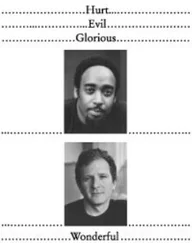Douglas followed his lead. “The women he’s been with are either many years younger, very naive, or much older and depend on him as their meal ticket,” he ventured. What’s more, the profilers determined, BTK would drive a “decent” automobile, but it would be “nondescript.”
At this point, the insights began piling on. Douglas said he’d been thinking that BTK was married. But now maybe he was thinking he was divorced. He speculated that BTK was lower middle class, probably living in a rental. Walker felt BTK was in a “lower-paying white-collar job, as opposed to blue-collar.” Hazelwood saw him as “middle class” and “articulate.” The consensus was that his IQ was somewhere between 105 and 145. Douglas wondered whether he was connected with the military. Hazelwood called him a “now” person, who needed “instant gratification.”
Walker said that those who knew him “might say they remember him, but didn’t really know much about him.” Douglas then had a flash—“It was a sense, almost a knowing”—and said, “I wouldn’t be surprised if, in the job he’s in today, that he’s wearing some sort of uniform…This guy isn’t mental. But he is crazy like a fox.”
They had been at it for almost six hours. The best minds in the FBI had given the Wichita detectives a blueprint for their investigation. Look for an American male with a possible connection to the military. His IQ will be above 105. He will like to masturbate and will be aloof and selfish in bed. He will drive a decent car. He will be a “now” person. He won’t be comfortable with women. But he may have women friends. He will be a lone wolf. But he will be able to function in social settings. He won’t be unmemorable. But he will be unknowable. He will be either never married, divorced, or married, and if he was or is married, his wife will be younger or older. He may or may not live in a rental, and might be lower class, upper lower class, lower middle class, or middle class. And he will be crazy like a fox as opposed to being mental. If you’re keeping score, that’s a Jacques Statement, two Barnum Statements, four Rainbow Ruses, a Good Chance Guess, two predictions that aren’t really predictions because they could never be verified—and nothing even close to the salient fact that BTK was a pillar of his community, the president of his church, and the married father of two.
“This thing is solvable,” Douglas told the detectives as he stood up and put on his jacket. “Feel free to pick up the phone and call us if we can be of any further assistance.” You can imagine him taking the time for an encouraging smile and a slap on the back. “You’re gonna nail this guy.” *
November 12, 2007
The Talent Myth
ARE SMART PEOPLE OVERRATED?
At the height of the dot-com boom of the 1990s, several executives at McKinsey & Company, America’s largest and most prestigious management-consulting firm, launched what they called the War for Talent. Thousands of questionnaires were sent to managers across the country. Eighteen companies were singled out for special attention, and the consultants spent up to three days at each firm, interviewing everyone from the CEO down to the human-resources staff. McKinsey wanted to document how the top-performing companies in America differed from other firms in the way they handled matters like hiring and promotion. But, as the consultants sifted through the piles of reports and questionnaires and interview transcripts, they grew convinced that the difference between winners and losers was more profound than they had realized. “We looked at one another and suddenly the lightbulb blinked on,” the three consultants who headed the project—Ed Michaels, Helen Handfield-Jones, and Beth Axelrod—write in their book, also called The War for Talent. The very best companies, they concluded, had leaders who were obsessed with the talent issue. They recruited ceaselessly, finding and hiring as many top performers as possible. They singled out and segregated their stars, rewarding them disproportionately, and pushing them into ever more senior positions. “Bet on the natural athletes, the ones with the strongest intrinsic skills,” the authors approvingly quote one senior General Electric executive as saying. “Don’t be afraid to promote stars without specifically relevant experience, seemingly over their heads.” Success in the modern economy, according to Michaels, Handfield-Jones, and Axelrod, requires “the talent mind-set”: the “deep-seated belief that having better talent at all levels is how you outperform your competitors.”
This “talent mind-set” is the new orthodoxy of American management. It is the intellectual justification for why such a high premium is placed on degrees from first-tier business schools, and why the compensation packages for top executives have become so lavish. In the modern corporation, the system is considered only as strong as its stars, and in the past few years, this message has been preached by consultants and management gurus all over the world. None, however, have spread the word quite so ardently as McKinsey, and, of all its clients, one firm took the talent mind-set closest to heart. It was a company where McKinsey conducted twenty separate projects, where McKinsey’s billings topped $10 million a year, where a McKinsey director regularly attended board meetings, and where the CEO himself was a former McKinsey partner. The company, of course, was Enron.
The Enron scandal is now almost a year old. The reputations of Jeffrey Skilling and Kenneth Lay, the company’s two top executives, have been destroyed. Arthur Andersen, Enron’s auditor, has been all but driven out of business, and now investigators have turned their attention to Enron’s investment bankers. The one Enron partner that has escaped largely unscathed is McKinsey, which is odd, given that it essentially created the blueprint for the Enron culture. Enron was the ultimate “talent” company. When Skilling started the corporate division known as Enron Capital and Trade, in 1990, he “decided to bring in a steady stream of the very best college and MBA graduates he could find to stock the company with talent,” Michaels, Handfield-Jones, and Axelrod tell us. During the nineties, Enron was bringing in 250 newly minted MBAs a year. “We had these things called Super Saturdays,” one former Enron manager recalls. “I’d interview some of these guys who were fresh out of Harvard, and these kids could blow me out of the water. They knew things I’d never heard of.” Once at Enron, the top performers were rewarded inordinately, and promoted without regard for seniority or experience. Enron was a star system. “The only thing that differentiates Enron from our competitors is our people, our talent,” Lay, Enron’s former chairman and CEO , told the McKinsey consultants when they came to the company’s headquarters, in Houston. Or, as another senior Enron executive put it to Richard Foster, a McKinsey partner who celebrated Enron in his 2001 book, Creative Destruction, “We hire very smart people and we pay them more than they think they are worth.”
The management of Enron, in other words, did exactly what the consultants at McKinsey said that companies ought to do in order to succeed in the modern economy. It hired and rewarded the very best and the very brightest—and it is now in bankruptcy. The reasons for its collapse are complex, needless to say. But what if Enron failed not in spite of its talent mind-set but because of it? What if smart people are overrated?
At the heart of the McKinsey vision is a process that the War for Talent advocates refer to as differentiation and affirmation. Employers, they argue, need to sit down once or twice a year and hold a “candid, probing, no-holds-barred debate about each individual,” sorting employees into A, B, and C groups. The A’s must be challenged and disproportionately rewarded. The B’s need to be encouraged and affirmed. The C’s need to shape up or be shipped out. Enron followed this advice almost to the letter, setting up internal Performance Review Committees. The members got together twice a year, and graded each person in their section on ten separate criteria, using a scale of 1 to 5. The process was called rank and yank. Those graded at the top of their unit received bonuses two-thirds higher than those in the next 30 percent; those who ranked at the bottom received no bonuses and no extra stock options—and in some cases were pushed out.
Читать дальше











